|
|
Dollar

|
|
 |
|
|
Dollar was an erratic race horse that won some good distance races on both sides of the English channel. Retired to the important stud of his breeder, and well-supported by an outstanding band of former winning English and French race mares with fine pedigrees, he became one of the most influential stallions in France. He was the principal conduit to extend the Byerley Turk sire line, which flourished in France up through the twentieth century, and is still active today.
|
His dam, Payment, was bred by Lord Chesterfield. She was by Slane, and out of Receipt, who had been bred by former jockey William Chifney in 1836. Receipt had produced a series of foals by some well-known race horses, such as Emilius, Don John and Cotherstone, but none of them were big winners, and she appears to have been sold in 1849, her last few foals were by horses of little merit. Her daughter Stamp (1842, by Emilius) later produced the Ascot Stakes winning filly Redemption (1852, by Orlando), whose line bred on, and Stamp's brother, Fitz-Roland (1855), who won the Two Thousand Guineas and the St. James's Palace Stakes. Receipt's unnamed dam, by Derby winner Sam, was also the dam of a filly by Whisker that bred on--the influential stallion Princequillo descended from this female line.
In 1848 Receipt dropped a chestnut filly, Payment, to the cover of Slane. Slane (1833, by Royal Oak, out of an Orville daughter), ran best at age four, where he proved to be a good stayer over distances around 2 miles, winning the 2-1/4 mile Somerset Stakes at Bath, Cheltenham's two mile Glochestershire Stakes, Winchester's two mile Queen's Plate, the 2-1/4 mile Oxford Cup, and the Waterloo Shield at Goodwood over 3-3/4 miles, among other races.
Payment was sold to a Mr. Ford, and at age three ran fourth in the Oaks and won Newmarket's Column Stakes, worth £775. She was retired to Ford's stud at the end of the season, and was bred the following year to the modest winner Caesar, producing a bay filly in 1853, after which she was bred to dual classic winner Surplice. Auguste Lupin purchased her -- and a number of other English mares -- that year and shipped her to his Haras Vaucresson in the Seine-et-Oise department, France, and in 1854 she dropped the Surplice colt. Named Florin, the chestnut colt won the Poule des Produits (later Prix Daru) and Poule d'Essai des Poulains (French Two Thousand Guineas) for Lupin.
Payment did not have another big winner until she was bred to the dual English classic winner The Flying Dutchman during his first season at stud in France, where he stood at the governmental depot in Paris. To his cover, she produced Dollar in 1860. A few years later, in 1864, she dropped a filly, Metallique, by the powerhouse sire Monarque, and this filly later bred Metallist (1881), winner of the Trial Stakes in England and later a winner Hungary.
Dollar, a bay that grew to 15.2 1/4 hands, was an assemblage of parts that on their own were generally good, but, taken as a whole presented a somewhat unbalanced appearance. Like his sire, he was long-backed, and wasn't as tall, and consequently appeared short-legged. He had pronounced withers, which emphasized the dip in his back, which only increased with age. He had a nicely sloped shoulder, but it lacked sufficient length, and like The Flying Dutchman, he had extremely powerful hind quarters. He inherited the tendency to be over at the knee. Despite his faults, he had a supple, light action, and an excellent temperament, unlike his fiery sire.
His breeder and owner, Auguste Lupin (1807-1895), was the son of a rich Parisian merchant who left Lupin a vast private income when he died in 1840. In his twenties, like other young sportsmen of his class, he was a fairly successful amateur jockey, and was a founding member of the Société d'Encouragement pour l'Amélioration des Races de Chevaux en France.
In 1845 he established the stud farm at Vaucresson, near Paris, to house the growing population of high-class broodmares he had begun importing from England, starting in 1833, among them the proven broodmare and former Oaks winner Wings, from the Hampton Court Stud sale; One Thousand Guineas winners Young Mouse and Tarantella; Doncaster Cup winner Fleur-de-Lis, and many other top runners and well-bred mares. It was Wings who produced Lupin's first classic winner in France, Fiametta (imported in utero, by Actaeon or Camel), the best of her generation at age 3 in 1841.
He became a noted breeder and owner of racehorses on both sides of the channel; it was his filly Jouvence, who was the first French-bred winner of a principal race in England, the Goodwood Cup. In 1867 he purchased Haras Viroflay, located not far from Vaucresson, significantly expanding his operation, and Dollar was the first important stallion installed there. Viroflay was an old, long-established farm that had been owned by the Comte de Morny and others before Lupin made its name famous as a nursery of outstanding runners. In all Lupin bred twelve winners of the French "Guineas" (both before and after they diverged as the One Thousand and Two Thousand Guineas); six winners of the Prix du Jockey Club; six winners of the Prix de Diane; two winners of the Grand Prix de Paris, winners of numerous other important French races, and winners of the Goodwood Cup and the Oaks in England. After Dollar's death in 1887, his pride of place -- and stall -- was assumed by Lupin's 1885 French Two Thousand Guineas winner Xantrailles, a son of Flageolet (grandson of Orlando) and Deliane, The Flying Dutchman's great running daughter that had been bred by Lupin from Orlando's classic-winning daughter Imperieuse. Lupin's stud was dispersed in several sales in the early 1890s, and he died in 1895.
Dollar on the Turf
Dollar was not the spectacular race horse that his sire was, being at most a useful runner who inherited The Flying Dutchman's stamina, but only a fraction of his speed, and more closely resembled his dam's sire, Slane, in his ability. He was, however, was a game horse who won important distance races in France and England.
Dollar was put in training with Yorkshire-born Joseph Hayhoe, who later trained classic winners for Baron Mayer de Rothschild. He did nothing of use on the turf in his two races as a juvenile, and after a fairly promising start at age three, proved to be less than high-class. He was also plagued by some undefined malady throughout much of the season, although his race schedule was not altered to allow him some time off, subjecting Hayhoe to some criticism regarding his use of "old training methods."
Dollar began by winning the Prix de l'Empereur (Grande Poule des Produits, later Prix Lupin) at Longchamp over 2100 meters, beating Charles-Martel. He started favorite for the Prix du Jockey Club (French Derby), but ran second, by two lengths, to the champion filly La Toucques. At Versailles he won the Prix de la Société d'Encouragement over 2200 meters, beating Charles-Martel. He went on in June to run third in the Prix de Fontainebleau over 3,000 meters, giving away weight to the winner, Charles- Martel. Shipped off to Baden-Baden, he placed third in the 2,000 meter Poule des Produits there, and then ran second to La Toucques in the 3200 meter Grand Prix de Baden-Baden (beating Charles-Martel). Back at Longchamp he won the 4000 meter Prix Principal. He failed to place, under heavy weight, in his last race of the season, the Prix St. Cloud over 3,000 meters. In all, he won three of his seven races at age three, and showed his preference for a distance and his ability to carry weight.
Dollar ran in a similar fashion at age four. He began by winning the 3200 meter Northamptonshire Handicap Stakes in England, beating a very moderate racehorse, Favori and a field of fifteen others, by five lengths, and conceding gobs of weight. Back in France, he won the Prix de l'Imperatrice (Prix Rainbow) over 5,000 meters, beating the good older mare Stradella (a winner of the French Oaks) by a nose. In June he beat Stradella again in the Prix de l'Empereur.
Then he was sent back across the channel to England to contest some summer races. On June 30 he ran second to Exchequer in the 2200 meter Worcestershire Stakes, giving away six pounds. Then, in late July, probably his greatest race, The 4,000 meter Goodwood Cup, which he won, beating a field of nine. He went on to Brighton, winning the 3200 meter Brighton Cup easily over his sole opponent, Little Stag. His last race in England was a second place to Oldminster in the 3200 meter Wolverhampton Handicap in early August. He had almost a month to recuperate before being sent to Baden-Baden, where he ran second to Vermout (giving him 20 pounds) in the Grand Prix de Baden-Baden, with the great Fille de l'Air third. His last race of the season and of his career was the Grand Prix de l'Empereur (later the Prix Gladiatuer) at Longchamp in October, won by Noèlie, where he ran third. His career statistics showed eight wins in nineteen starts, with five second-place finishes, three thirds, and three times unplaced.
A Different Story in the Stud
At the end of 1864 Dollar was retired to Lupin's Haras Vaucresson, and was moved to nearby Haras Viroflay after Lupin purchased it in 1867; Vaucresson became a subsidiary farm for broodmares, who were taken up near their due-date and moved for foaling to Viroflay, where the stallions, youngsters, and mares with foals were lodged. By 1872 his stud fee was 500 francs, the equivalent of that charged for Trocadéro, but well below the 1,000 franc fee charged for the services of The Nabob, Tournament, and Light. At Vaucresson and Viroflay the modest stayer became one of France's most influential stallions, both in his own time as a sire of winners of four million francs, and forever after as progenitor of the Byerley Turk sire line, which due to his sons, flourished in France.
Dollar was supported by Lupin's stellar band of imported English mares, either top winners themselves or sisters or half-sisters of outstanding English runners with the most fashionable bloodlines, and by French mares with the equivalent French form or pedigree. Many of the other most influential breeders of the latter 19th century in France, such as A. Desvignes, Henri Delamarre, the Comte de Berteux, and the Rothschilds, also bred some of their best mares to him.
Dollar led the sire's list in France in 1878, and was second and third three times each. He got two Prix du Jockey-Club winners, two French Guineas winners, a French Oaks winner, and many other successful runners. His French Derby winning son UPAS continued the sire line for a while, and one of his less successful runners, ANDROCLÈS, got a son, Cambyse, whose classic winning son, Gardefeu, ensured continuation of the line, with descendants including many stallions of world-wide influence and top-class runners, such as Brûleur, Ksar, Tourbillon, Goya II, Djebel, Ambiorix, and Le Lavandou. Its most recent representatives include recent "Chef-de-Race" Indian Ridge (1985), English champion colt Dr. Devious (1989), and Inchinor (1990).
Androclès
Dollar's most influential son was ANDROCLÈS (1870), born at Haras de Bazouges at Marseillère, out of the French-bred Alabama, who had won the Prix l'Omnium for her owner A. Desvignes. Desvignes had modest success as an owner and then retired to concentrate on breeding. He had a deal with the Duke of Hamilton, who had a racing stable in France, but not a stud farm, wherein he would sell the best youngsters produced at Bazouges to the Duke; the dark bay ANDROCLÈS was one of these. He did not run at age two, and his best win was, like his mother's, l'Omnium, a 2400 meter handicap for French-bred three year olds and above, run at Longchamp (prior to that it had been open to juveniles as well, and run at Chantilly). According to contemporary descriptions, he was long in the back, like his sire and grandsire, and had two small "horn-like" bumps above his eyes, which The Flying Dutchman's son, Dutch Skater, also displayed.
Androclès' most important offspring was Cambyse (1884, from Cambuse by Plutus), a "really good" winner of nine races, with five places in fifteen starts (unplaced only once), owned by the Comte de Berteux. At de Berteux's Haras de Cheffreville, standing along side of UPAS (see below) Cambyse got several good runners, most sold at the Deauville yearling sales. These included Codoman (1897) purchased as a yearling for 20,000 francs and later a good juvenile, winning the Criterium International d'Ostende, the Premier Criterium, and the Prix de Condé, and at age three winner of the Prix Lagrange, Biennal Deuxieme, the Prix Monarque, and the Prix du Conseil Municipal, and was second by half a length in the Prix du Jockey Club.
|
| 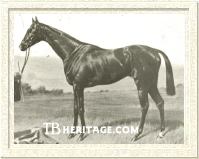
Androclès' grandson Callistrate
| | 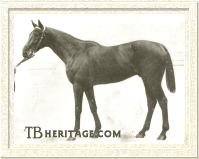
Androclès' grandson Gardefeu
| |
Cambyse's son Callistrate (1890), bought for 7,000 francs at Deauville, won the Poule des Yearlings Cheri, the Prix Lagrange, at Maisons-Laffitte, and the Grande Poule des Produits at age two. His wins at age three included the prix Conseil Municipal. But the Cambyse son to have the greatest impact on the breed was J. de Brémond's Gardefeu (1895), one of the top three year olds of his generation. Ill for most of his juvenile year, he debuted at three in the Poule d'Essai, running third, after which he won the Prix Lupin and the Prix du Jockey Club. He was beaten by Le Roi Soleil in both the Grand Prix de Paris and the Prix Royal-Oak, but went on to win the Prix du Prince d'Orange and the Prix du Conseil Municipal. At age four he was shipped to England to unsuccessfully contest the Ascot Gold Cup, after which he returned to France, winning the Prix des Sablons, the Prix Hédonville, and the Prix de Dangu. He got a number of good producing daughters in the stud, and sons Quintette, who dead-heated for first with Sea Sick in the Prix du Jockey Club, and Chouberski (1902), who did nothing on the turf, having injured himself early in his career, who continued the sire line through his successful sire son, the in-bred (to Dollar) Brûleur.
Upas
Dollar's son UPAS (1883) was a handsome chestnut colt who resembled his leggy and somewhat upright dam, the Skirmisher daughter, Rose-Mary, who had been purchased in England in the late 1870s by the Comte de Berteux and installed at his Haras de Cheffreville in Normandy.
|
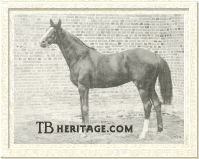
Upas
| |
At age three Upas went off at odds of 40:1 for the Prix du Jockey Club, and dead-heated for the win with Sycomore; that season he also won the Prix Hocquart and the Prix de Chantilly. At age four he went on to prove himself a good stayer, winner of the Prix de Dangu, the Prix de Satory, the Prix Jouvence, and the Prix Gladiatuer (6200 meters), and dead-heated with Firmament for the Prix Rainbow (5000 meters). At age five, in 1888, he won several provincial races, and at the end of the season was retired to stud at Cheffreville. |
| He was a successful sire of great stayers, but his best was Omnium II (1892), a terrific runner in France purchased as a yearling at Deauville by Evremond de Saint-Alary. At age three Omnium II won the Prix du Jockey Club, the Prix LaGrange, and the Prix du Conseil Municipal (2500 meters). The next year he demonstrated the strength of his paternal inheritance, winning the Prix du Conseil Municipal again, the Prix Boïard, and the distance races the Prix Rainbow and the Prix Gladiateur. He was retired to the Haras de Saint-Pair--du-Mont, near Calvados, Normandy, that Saint-Alary had purchased from Léonce Delâtre, where he got for Saint-Alary the great filly Kizil Kourgan, winner of the Prix de Diane and the Grand Prix de Paris, and Basse Terre, dam of Prix de Conseil Municipal winner Basse Pointe and the in-bred Grand Prix de Paris winner Brûleur (by Chouberski), the best colt of his generation in France, and later an influential sire of Ksar and others.
|
| 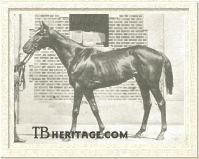
Dollar's grandson Omnium II
| | 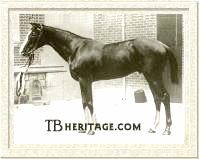
Dollar's grandson Elf II
| |
UPAS also got Elf (1893), from the unraced Adventurer daughter, Analogy. Owned by J. de Bremond, he was a great stayer, a two-time winner of three races in successive years: the Prix Rainbow, La Couple de Paris, and the Prix Gladiateur, and in England he won the Ascot Gold Cup. In the stud he got two champions: Sea Sick, who dead-heated for the Prix du Jockey Club with his near relative Quintette, and won a number of other races, including the Grand Prix de Saint Cloud, the Prix Jean Prat, the Deauville's Prix Kergorlay (twice); and Nimbus, winner of the Prix du Cadron, Prix du Conseil Municipal, Prix de Sablons, and other important races in France.
Another UPAS son was Ivoire, also owned by de Bremond, who won the Prix Royal Oak (French St. Leger) in 1900. UPAS also got Kelibia (1900), who produced Eulogy (1911), an incredibly influential broodmare in New Zealand. Kelibia's last foal was Double Chance, winner of the 1925 Grand National Steeplechase at Aintree.
Dollar's Other Sons
Dollar got a great many good running sons in France, and some that crossed the channel to win important handicaps in England. One of these was SALVANOS (1869), out of the Ion daughter Sauvagine, who won the Cesarewitch Handicap Stakes, beating a big field of 24.
Salvanos had a younger brother, Lupin's SALVATOR (1872), who was the champion colt of his three year old year, undefeated in his seven races, which included the Prix de l'Esperance, the Prix Reiset (over 3000 meters, its inaugural running), the Prix Seine-et-Marne at Fontainebleau, the Grand Prix de Deauville, the Prix Dagnu, and the two big ones -- the Prix du Jockey Club and the Grand Prix de Paris. Something went wrong with him after that, and he appeared only once at age four, in the Prix de Deauville, in which he ran second to Nougat. He was trained by Joseph Hayhoe, and ridden by a former exercise jockey named Wheeler, when Lupin's principal jockey, Hudson, expressed a preference for the other Lupin powerhouse in Salvator's three-year-old season, ST. CYR (also by Dollar), Hudson believing St. Cyr was the superior runner.
|
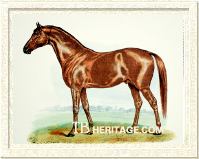
Salvator
| |
SALVATOR was sold to England for stud, and was lodged at Cookson's Newham Stud. In England he got the bay Ossian, out of the Stockwell daughter, Music, who was raced by the Duke of Hamilton: Ossian won the 1883 Doncaster St. Leger by three lengths for Hamilton, one of two classic winners for the Duke, and also won York's Great Yorkshire Stakes, the Sussex Stakes and the Drawing-Room Stakes at Goodwood, and the Great Foal Stakes at Newmarket. Ossian was retired to stud in 1884 and was sold to the U.S. in 1890. Another Salvator colt, Elzevir, took part in Ossian's St. Leger, finishing a bad fourth. Back in France Salvator got several good runners, including Lapin, winner of the Prix du Cadran in 1886 for the Duc de Castries. |
SALVATOR'S generational rival in France was Dollar's son ST. CYR (1872), out of Finlande, another great producer for Lupin, who was, like Sauvagine, by Ion. He was also owned by Lupin, and trained by Hayhoe. He was a good runner, promising early in his three-year-old year, but proved to be inferior to his stable-mate. He won the Prix de Longchamp (later Prix Hocquart) over 2500 meters, and the Poule d'Essai at Champ de Mars over 2000 meters (later split into the French 1,000 and 2,000 Guineas), and the Grand Prix de Deauville, but could only dead-heat for second with the Consul son Nougat in the Prix du Jockey-Club, behind Salvator, and in Salvator's Grand Prix de Paris, ran fourth behind Nougat and Perplexe. At age four his big win was the 2500 meter Prix du Cadran.
St. Cyr's dam, Finlande (1858, by Ion), had been a very good runner, winner of the Prix de Diane (French Oaks), the Prix de la Foret, and the Prix de l' Empereur (Prix Lupin), among other races, for Le Grande Écurie, an experimental racing monopoly whose principals were the Comte Frédéric de Lagrange and the Baron Nivière that lasted about two years; Finlande was one of its representatives (which included some other very good race fillies), running in the name of de Lagrange. It was dissolved in 1862, and Finlande, along with some other outstanding horses (Gabrielle d'Estrèes, Compiègne, Stradella, Hospodar, Fille de l'Air), was put on the auction block. De Langrange got many of the good ones, but Finlande was picked up for 8,000 francs by the Baron, and was sold soon after, at age five, to Lupin for 10,800 francs, and entered the broodmare band at Vaucresson, and later Viroflay. She had foals by Fitz-Gladiator and Tournament, but after Dollar arrived, she was bred exclusively to him, and a most happy cross it was. She died after a long, productive career at Haras de Viroflay at age 25.
In addition to St. Cyr she produced FONTAINEBLEAU (1874), who was second to Jongleur in the Grande Poule (later Prix Lupin) and then beat him in the Poule d'Essai (the Guineas before it was split by gender) at Longchamp, and won several other races at age three. At age four he won the Prix de la Seine, the Seine-et-marne, the Prix du Consil General at Rouen, the Grand Prix de Veauvais and the Prix de Bois-Roussel. He stood at Viroflay for a while, and at age sixteen was sold for 17,000 francs to J. Arnaud and entered his stud. He got the Poule d'Essai de Poulains (French Two Thousand Guineas) winner Phlegethon and Prix Morny winner Fontanas, who bred on.
Finlande also produced two good daughters to Dollar: FIDELINE (1871) AND BRIENNE (1877). FIDELINE was very good juvenile, winning the Grand Criterium, beating the colts. In the stud she produced Galaor (1885), winner of the Prix Royal-Oak, the Prix Jean Prat, and the Grand Prix de Deauville; he was later sire of Weathercock. BRIENNE was a promising juvenile, but fell during the running of the Prix de la Mourlaye, and her jockey, St. Cyr's rider Hudson, was trampled. She later won the second Prix d'Automne at Mais with him aboard, but both her career and that of her jockey's was over. As a broodmare at Viroflay she produced Polygone (1891, by Xantrailles), winner of the Prix Jean Prat and the Prix Hocquart.
Another good mare owned by Lupin, La Maladetta (1855), was a daughter of The Baron; she won the Grosser Preis von Baden. In the stud she produced some good offspring for Lupin to the cover of The Flying Dutchman, and a daughter, Cerdagne, by Newminster, who also won the Grosser Preis von Baden and other good races. As an older mare La Maladetta was bred to Dollar, producing two colts of interest: NETHOU AND VIGNEMALE. NETHOU (1869) won the Poule des Produits at the Champ de Mars. VIGNEMALE (1872), wasn't that successful as a runner, but he got Prisme (1890), an Anglo-Arab that won the Prix des Haras at Limoges, the Prix du Governement at Pompadour, and the Prix Ministere at Aurillac.
Dollar's son LOUIS D'OR (1877), out of Charmille, by The Nabob (a leading sire in France), won fourteen races for the Baron Alphonse de Rothschild. He was a very good and heavily raced juvenile who won the Prix de Villers and the Prix de Deux Ans, and dead-heated in the Criterium with Basilique, necessitating a run-off. Many felt this effort affected his later career, in which every single of his fourteen wins through age seven was a hard-fought battle, where "only his courageous heart" carried him to a win by a head or neck. He won the Prix Mornay, and, at age seven, the Doncaster Cup in England. He was sold to Argentina for stud duty at age ten. His dam, Charmille, also produced THE CONDOR to the cover of Dollar, and later the aforementioned Fontanas, by Dollar's son Fontainebleau. THE CONDOR was a good runner, winner of the Grand Criterium, some provincial races, Le Coupe and the Triennial, and the Prix Rainbow (5000 meters). One of his offspring was Cloridano, winner of the Gran Premio del Re Imperatore (later the Italian Derby).
MARTIN PÉCHEUR (1881) was out of Schooner, by imported Father Thames. At age four, owned by Maurice Ephrussi, he won the Prix de Chevilly, the Prix de Bagatelle, the Prix Satory, the Pris de Seine-et-Marne, and the Prix du Prince de Galles over 2400 meters, beating the great Plaisanterie--her only loss that season. Schooner also had two good producing daughters to the cover of Dollar that were sisters of Martin Pécheur: LAVANDIERE and MOISSONNEUSE (see below).
|
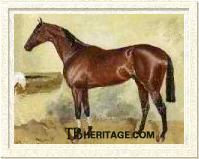
Acheron
| |
Another mare in Lupin's stud was Promise, an 1869 daughter of Monarque, out of the grand French classic winning filly Mlle. De Chantilly (by Gladiator). Promise produced two daughters for Lupin: Ismenie (1877, by Plutus), and URGENCE (1884) by Dollar. Ismenie in turn produced several good colts for Lupin, including Dollar's son ACHERON (1884), winner of the Prix des Sablons and the Prix de la Foret; CERBERE (1887), another Dollar son, who won the Prix Greffulhe, and the aforementioned French Two Thousand Guineas winner Phlegethon, by Dollar's son, Fontainebleau. Urgence was later dam of Maximum (1899 by Chalet), a great stayer who won the Prix Hocquart, the Prix Greffulhe, the Prix Rainbow, the Prix Gladiateur, the Grand Prix de Deauville, and the Ascot Gold Cup in England; he was later sire of some good horses, including Opott II. |
Other Dollar sons included: SANSONNET (1881), whose dam was Ortolan, by Saunterer, who won the Derby de l'Est, the Prix de Lutece, and the Prix de la Seine; SAINT-HONORÉ (1883), from the Vermout mare, Vivienne, won the Grand Prix de Bruxelles and the Prix Reiset for Lupin; BOCAGE (1885), from the Chattanooga mare Printaniere (also dam of Rous Memorial Stakes winner Poulet and Grand Prix de Bruxelles winner Feuillage by different sires), won the 1888 Prix Greffulhle over 2100 meters for Lupin; THIEUSIES (1874), out of Trompette, won the Belgium Derby. He later got Colqueluche (1884), another winner of the Belgium Derby.
Dollar's Daughters
Schooner, the dam of MARTIN PÉCHEUR, also produced two good daughters to Dollar. LAVANDIERE (1882) bred on, with good winners such as Zalataia (1979, Grand Prix de Deauville and the Oak Tree Invitational Handicap, among others) descending from her in tail-female. Schooner's daughter MOISSONNEUSE (1884) had a huge impact on South American breeding. She was sent to Haras Viejo in Argentina, and in 1901 dropped a chestnut foal to the cover of imported Orbit, who had won the Craven and the Eclipse Stakes in England before his purchase by Felix Rivas.
|
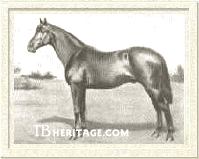
Dollar's South American grandson, Old Man
| |
Named Old Man, the colt was the indisputable champion of his generation in Argentina, running for La Petite Ecurie. He won all but one of his nineteen races during his three seasons on the turf, which included all the important classics in Argentina, among them the Gran Premio Pellegrini (twice), the races comprising the Argentine "Quadruple" Crown, and the Gran Premio de Honor (twice). He had a huge influence in the stud, becoming known as the "Stockwell Sudamericano," with winners of 685 races in Argentina, including 130 classics. |
He was three-times leading sire there, and nine times leading broodmare sire, and was also a sigificant influence in Chile. Probably his most important offspring was Botafogo, also winner of the "Quadruple Triple Crown" races in Argentina at age three, and many other races, and was a good sire who died prematurely.
Dollar's daughter CLIO (1879) was born at Haras de Bois-Roussel, near Bursard, which was owned by the Roederer family, and operated by Henri Delamarre, where the Société d'Encouragement paid rent for the care and management of its stallions and mares; Delamarre also had a nearby stud at nearby Gouvieux, where he kept some broodmares.
|

Clio
| |
Clio was out of Clotho, by Bois Roussel. Clotho had been a very good fily on the turf, winner of the prix des Acacias, the Prix du Lac, the prix des Ècuries, the Grand Prix de Bourgogne, the Sain-Léger Continental at Baden-Baden, the Prix de Chantilly, and the Prix Royal-Oak. She was a foundation mare at the stud, and in addtion to Clio, was the dam of Clodore, by Stracchino, winner of the Prix Lupin, and several daughters that bred on. |
Clio was the best offspring of her dam. Running for Delamarre, at age three she won the 2100 meter Prix Greffulhe at Longchamp, the Biennial (Prix Jean Prat), and the Prix Royal Oak, and ran second to Mademoiselle de Senlis (the best filly of the year) in the Saint-Leger de Caen. At age four she won the Prix d'Apremont, and the Prix de Deauville. Clio was returned to Bois-Roussel as a broodmare, and produced a daughter, Ciantelle that bred a winner of the Grand Prix de Bruxelles.
Another classic-winning daughter of Dollar's, also owned by Delamarre, was VERTE BONNE (1880), out of the Patricien daughter Verte Allure, who was a half-sister of the influential stallion Vermout. Verte Bonne placed second in the Prix Salamandre to the champion juvenile filly Chitrè, and went on to become an unexpected winner of the Prix de Diane, who went off at odds of 40:1. Her daughter, Verdiere (1883 by Idus) produced Grand Prix de Deauville winner Van-Diemen (1894).
One of the good-running English mares Lupin had imported for use at Viroflay was Gardevisure (1862, by Vedette), who had won the Camridgeshire Handicap and the Woodcote Stakes, and was half sister to English Triple Crown winner Lord Lyon and dual-classic winning filly Achievement and their other winning siblings and half-siblings out of the great producer Paradigm (by Paragone, Family 1 - j). She produced VOILETTE (1877) to the cover of Dollar, who ran second in the Prix de Diane, and won the Prix Daru in 1880, and CIMIER (1879), who won the Prix du Nabob (Prix Noailles) for Lupin in 1882.
Dollar's daughter ALMANZA (1872), out of the Iago daughter Bravade, won her debut race as a juvenile for Lupin, the Prix de Conde. At age three she won Poule Des Produits at Champ de Mars (later Prix Daru) over 2,000 meters, and the next season she won the Prix de Bois-Roussel. ASTREE (1874), whose dam was Etoile Filante -- a good race filly who had won the Prix Royal-Oak and the Grosser Prix von Baden -- won the Prix Morny and the Prix de la Forêt. Another Dollar daughter, out of the Ion daughter Lady Tartuffe, was TARTANE (1871): she won the Prix du Premier Pas for Lupin, and in the stud she produced a son, Tantale, who won the Grosser Preis von Baden.
Another mare at Viroflay was Pergola, by The Baron. She produced several daughters to the cover of Dollar. One, PERLA (1871) was a good juvenile, who won the Prix de Deux Ans and the Prix Morny. She went on to run second to Destinee in the Prix de Diane, and to win the Grand Prix de Deauville, beating Saltarelle, who had won the Prix du Jockey-Club. Her daughter, Cromatella (1887, by Wellingtonia) won the Grand Criterium and Prix Morny at age two, and later produced Cheri to the cover of St. Damien; Cheri was one of the best of his generation, winner of the Poule d'Essai des Poulains, the Grand Prix de Paris and the Prix Boïard, and later a successful sire. PERLA'S sister, PRISTINA (1875) produced Presta, a winner of the Prix de Diane, and another sister, PENSACOLA (1872) bred on.
Jeanue Premiere, a daughter of West Australian bred by Lupin, won the Prix de Diane. After she retired to Viroflay he bred her to Dollar several times, resulting in LA MIGNARDE (1870), GARRICK (1880, later a sire in Italy) AND VESTRIS (1881). La Mignarde bred on; several good South American runners descended from her.
Imperieuse, the excellent English race filly who had won the the One Thousand Guineas and the Doncaster St. Leger, was also purchased by Lupin and added to his impressive band of broodmares. She produced the Prix de Diane winner Deliane to the cover of The Flying Dutchman, who became the dam of English Oaks winner Enguerande and the great French filly and Prix de Diane winner La Jonchere (both by Vermout), and Lupin's French classic winner and later principal stallion Xaintrailles (by Flageolet, and so in-bred to Orlando). One of Imperieuse's last foals was ERMELINE (1868) by Dollar. In the stud Ermeline produced Yvandre (1881, by Montargis), winner of the Poule d'Essai des Pouliches, and other races, and later dam of Melchior (by Xaintrailles), a winner in Germany.
Dollar died at Haras Viroflay in 1887, age twenty-seven. In 1905 he was commemorated by the establishment of the 3500 meter Prix Dollar at Longchamp, now a 1950 meter Group II race. His owner and breeder, Auguste Lupin, had been honored earlier, just after his death, in 1895, by the re-naming of the Prix de l'Empereur, a race for three-year-olds at Longchamp run over 2100 meters.
--Patricia Erigero
|
|
|
|

